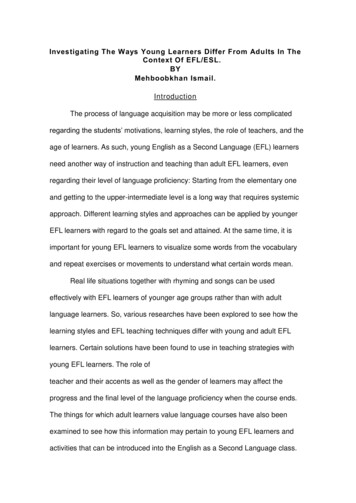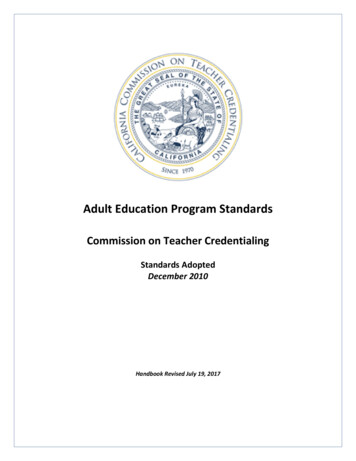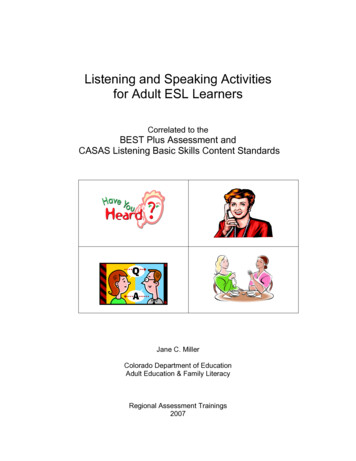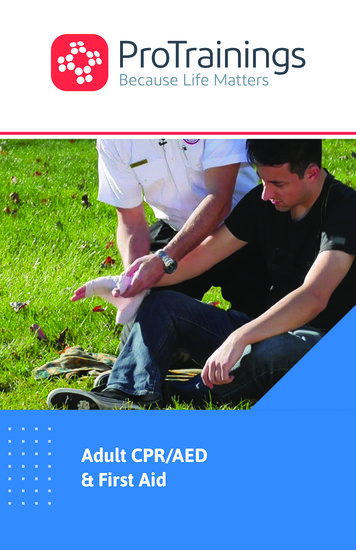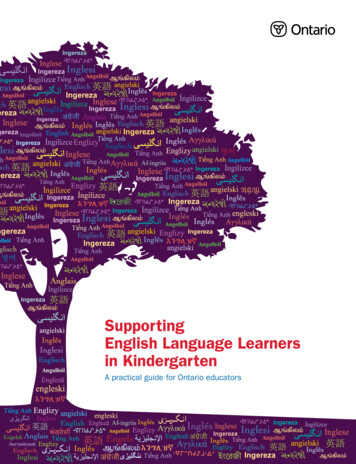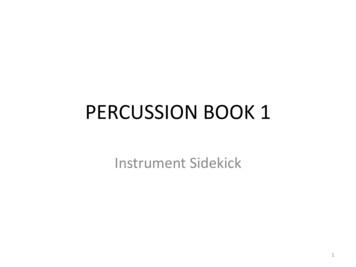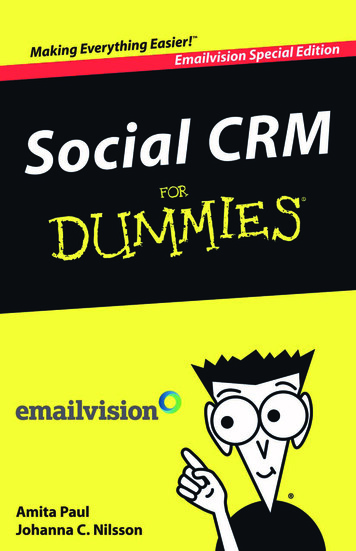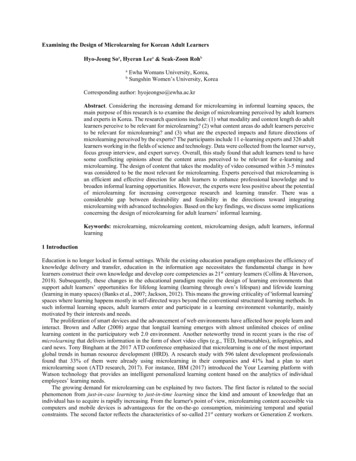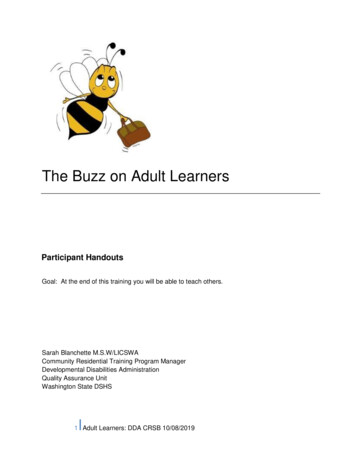
Transcription
The Buzz on Adult LearnersParticipant HandoutsGoal: At the end of this training you will be able to teach others.Sarah Blanchette M.S.W/LICSWACommunity Residential Training Program ManagerDevelopmental Disabilities AdministrationQuality Assurance UnitWashington State DSHS1 Adult Learners: DDA CRSB 10/08/2019
Purpose: In order to be the most effective trainer you can be, it isimperative that you understand how adults learn and how to structure atraining experience that will transform the lives of those you support withinDevelopmental Disabilities Administration.Learning Objectives: Demonstrate principles of Adult EducationApply three learning styles to trainingEngage participants through interactive learningRespect and value cultural, generational and gender learningstyle differences Integrate effective facilitation into training Produce participants who can repeat what they learned twoweeks after they were trained.2 Adult Learners: DDA CRSB 10/08/2019
A little something about the people we teach .How to reach adult learners:Information must be immediately useful.How does the information you are providingapply to daily work?Relevant: Adults will not retain information thatthey will rarely use. Adults need to relate theirexperience to the learning to make it relevant.The environment should be welcoming: setup before participants arrive, greet participantsas they arrive, have activities ready that areengaging and fun.Engaging. Avoid using really longPowerPoints, adults need activities, time todiscuss big concepts. Adults also need topersonalize trainings before they can relate thatlearning to other areas of practice.Respectful. Introduce yourself. Smile! Saythank you, use people’s names (there is nothing more personal), set group agreements or groundrules. At the beginning of each training let adults know where the restroom are located, whenbreaks (including lunch) will be and when the training will end. Keep those agreements. Showthat you are valuing different learning styles, adaptive methods for everyone to participate. Allowfor people to tell their own stories when it is applicable. Encourage participation. Provide multiplechecks for understanding in fun and simple ways. When working with people with English as asecond language allow for cell phone use as translation tool, speak slowly, provide additionalpractice and support opportunities, work in small groups to allow for individual learning.Varied Activities:1.2.3.Visual Learners need lots of color, tables and graphs, pictures.Auditory Learners need to hear everything. Sometimes they will talk out loud to helpthemselves learn.Kinesthetic learners need to do it. The action of the process helps them to retaininstructions and information. They will want to knit, bead or do other things duringclass to keep their hands busy. If you keep them moving, they will be happy!3 Adult Learners: DDA CRSB 10/08/2019
Learning Styles QuestionnaireSeldomOftenlearning style.SometimesComplete the following questionnaire by ticking the appropriate box to discover your preferred1Can remember more about a subject through listening than reading. 2Follow written directions better than oral directions. 3Like to write things down or take notes for visual review. 4Press down extremely hard with pen or pencil when writing. 5Require explanations of diagrams, graphs or visual directions. 6Enjoy working with tools. 7Enjoy developing and making graphs and charts. 8Can recall an acquaintance’s voice more than their face. 9Remember best by writing things down several times. 10Can better understand and follow directions using maps. 11More engaged in training that includes listening to lectures or watching videos 12Enjoys fig-it toys when listening, often plays with coins and keys in pockets. 13In school, learned to spell better by repeating the letters as opposed to writing. 14Prefer to read books vs. listen to books on audible or on tape 15Chew gum or snack during studies. 16Feel the best way to remember a picture is in my head. 17Learn spelling by ‘finger spelling’ the words or do basic math using finger counting. 18Would rather listen to a good lecture or speech than read about the same material. 19Good at working and solving jigsaw puzzles and mazes. 20Grip objects in my hand during learning periods. 21Prefer listening to the news on the radio than reading about it in a newspaper. 22Obtain information on an interesting subject by reading relevant materials. 23Feel very comfortable touching others, hugging, handshaking, etc. 24Follow oral directions better than written ones. Adapted within: Primary Learning Mentor Training – Trainer Manual DFEE/Liverpool Excellence Partnership4 Adult Learners: DDA CRSB 10/08/2019
ScoringAward yourself 5 points for OFTEN, 3 points for SOMETIMES and 1 point for SELDOM.Complete the grid by filling in the values and totalling each column. Transfer your score to the‘tripod’ to get a visual display of your 010103040kinaesthetic5 Adult Learners: DDA CRSB 10/08/2019203040auditory
Learning ActivityHave each trainee take the learning styles quiz then divide the class into groups according tolearning styles. Have Visual Learners at one table, have Auditory Learners at 2nd table andKinaesthetic Learners at a 3rd table. Give each group a large easel paper.Phase #1: Top half of the easel paperAsk each group to write bullet points describing the WORST training they have ever attended.Ask Visual learners to describe how this training was THE WORST for visual learners, Auditorylearners describe how this training was THE WORST for auditory learners and kinaestheticlearners the same directive. Trainees in each group could be describing different trainings themost important thing is that they are thinking of ways that training did not support the needs of avisual learner.Debrief this, ask each group to describe their list and how that training DID NOT support theirlearning style. Ask if that training might support other learning styles?Phase #2: Bottom half of the easel paperAsk each group to write bullet points describing the BEST training they have ever attended. AskVisual learners to describe how this training was THE BEST for visual learners, Auditory learnersdescribe how this training was THE BEST for auditory learners and kinaesthetic learners thesame directive. Trainees in each group could be describing different trainings the most importantthing is that they are thinking of ways that training DID support the needs of a visual or auditory orkinaesthetic learner.Debrief this, ask each group to describe their list and how that training DID support their learningstyle. Ask if that training might NOT support other learning styles?Phase #4: New easel PaperPass out a fresh easel paper to each group. Ask each group to review the material below thatgives information on the needs of each learning style. Ask each group to think about how theywould plan a training or learning activity that could support each learning style. Have them writedown ideas of how they would set up a classroom, curriculum and plan a learning environmentthat supports all learning styles.6 Adult Learners: DDA CRSB 10/08/2019
What:Adult learning theory (ALT) suggests that not all adults learn in the same manner. What ishelpful for one individual may not be helpful for another individual in a learningenvironment. ALT suggests that we do the following when learning is going well: Set a collaborative climate to learn together Assess individual learning styles and needs Develop learning based on the individual’s interests, needs, and skill levels CollaborateThere are at least four learning styles:7 Adult Learners: DDA CRSB 10/08/2019
8 Adult Learners: DDA CRSB 10/08/2019
Generational differences in learningWhile our student population is adults we have to be aware of Generational differences. Ourworkforce is becoming increasingly diverse as new generations enter the workplace. TheAmerican life expectancy has also increased and that means adults are spending more of theirlifetime in the workplace than ever before. According to Malcolm Knowles, a well respectedresearcher in the area of generational differences, there are four generations. They are allworking in the same environments, attempting to follow the same rule. Your challenge as ateacher is to honor all of this along with their learning styles which will cross generations.Generation Activity: take a minute and look at the cultural events and generational values andattributes that research has revealed about each generation. At your table talk about how culturalevents may have impacted each generations values, experiences and collective attributes.Baby Boomers – Born 1946-1964Historical EventsWomen’s Rights MovementCivil Rights MovementDisability Rights MovementWoodstock (rock n roll festival)Higher Divorce Rate/High Rate of 2nd MarriagesHuge Advances in Healthcare (polio vaccine)GI Bill (Post WWII)Typically married between ages of 18-23Average family had 4 childrenAv. age of first job 14 yrs old ( 3.65 min wage)Grew up with no computers/analog phonesGeneration X – Born 1965-1980Historical EventsRoe v. Wade (abortion legalized)/Birth controlpill introduced in 1960)Watergate/President Nixon resignsHIV/AIDS EpidemicRodney King and OJ Simpson TrialColumbine Shooting (mass school shooting)9/11 terrorist attack on the U.S.Dot Com boom/huge technology boomSmallest Generational co-hortIncreased Immigration ratesEvidence-Based Group Values & AttributesUncomfortable with conflictPersonal growthSensitive to feedbackHealth and wellnessPersonal GratificationBig picture / systems in placeBring fresh perspectiveDo not respect the titlesDisapprove absolutes and structureOptimismTeam OrientationEvidence-Based Group Values & AttributesFlexible hours/Informal work environmentGreat at and enjoys Multi-taskingWork to live vs. live to workSelf-relianceThinking globallyQuestion the authorityPositive attitudeImpatienceGoal oriented9 Adult Learners: DDA CRSB 10/08/2019
Millennials (aka Generation Y) – Born 1981 and afterHistorical Events(Evidence-Based Group Values & AttributesHuge Advances in Technology (especiallyTechnological savvypersonal technology: smart phones, etc)Largest generational cohort (will be half theTenacityworking population by 2020)First generation born into a digitally connectedCollective actionand globalized worldMost diverse generational cohortLack of skills for dealing with difficult peopleFastest growing customer/consumer in theMulti-taskingmarketplaceHousing crash/economic deficit of 2008Need flexibilityRise of Social Media (Facebook/Twitter)ConfidenceAfghanistan/Iraq WarSociabilityRise of online datingMoralitySchool Shootings & Mass Shootings increasedStreet smartsFirst African American President of the U.S.DiversityGender and Learning:According to the latest research onadult-based learning shows that adults,regardless of gender identity, prefermultimodal learning. This means thatadults need to interact with their learningthrough, reading, discussion, activitiesand practice.**It is important to note that there aregaps in research around adultlearning for and with individuals whoidentify as transgendered or as nonbinary.Cultural Considerations:10 Adult Learners: DDA CRSB 10/08/2019
Cultural influences deeply affectadult learning. If you areworking with individuals whowere not raised in the UnitedStates or speak English as asecond language you will needto be open to learning how theyneed and want to engage withwhat you are teaching. It isimportant to learn aboutdifferent cultural communities inyour area. Use multimodallearning to meet different needsin your classroom. Forexample, using picture-basedvisuals, creating opportunities tofor discussion and practice,would be ways to offer abroader approach to learning. Itwill also be a way for you toinformally track your traineeslearning progress and adjustaccordingly. It is also importantto pay attention tocommunication needs, is moretime needed before they answerquestions, can you do moresmall group work so peers canhelp each other, etc.Visual Facilitation: Maps the process during a meeting and documentsthe path or journey taken.Teaching Students with English as a second Language (ESL)Culture Shapes: how we communicate what we do in our work and play how we interact with one another what customs we follow how we view the worldESL students are simultaneously working to develop: a grasp of the knowledge, skills and attitudes of various topics in a very short timeframe. a better command of basic English and the more advanced Medical terminology. an ability to interact with others and function with the social environment in the class.11 Adult Learners: DDA CRSB 10/08/2019
And in every case, it will depend on the student. Only they really know how theenvironment, knowledge and experience will impact their learning ability and they will allhave different ways to deal with their learning process. Strategies that may be most effective for ESLBe organized and have your classroom organizedBe clear on your expectations of every studentClearly mark transition timesShow students how materials are organizedPoint out the key points on the pages as you go through the materials.Be clear which page you are on so students aren’t searching for where you areAllow for students to pre-read the information you are going to teachRephrase difficult language and teach what the acronym stands for!Be aware of certain restrictions based on religion and cultureSpeak slowly – pace yourselfGive plenty of time and wait for responsesRepeat and clarify main pointsUse pictures of real objects when possible or the real thing!Use cooperative learning (small groups and partnering)When listing things on flip charts separate different lines with a new color. This will help toseparate one thought from another.12 Adult Learners: DDA CRSB 10/08/2019
Evidence Based Effective Teaching StrategiesHook: Hook is different from an icebreaker a hook engages a participant is what theyare going to learn that day with a simple activities. Find something everyone can relate to, setthe tone for the information they will receive. odeling: adult learners can benefit from watching others perform a taskbefore they attempt the task themselvesInstruction: Limit your “lecture” time, no more than 10-15 minutes before a discussion,break or activity. It helps to pair lecture time with visual learning. Relate the newinformation to things that participants already know. Preparing a lecture takes planning.Did you know it takes an average of 3-6 month to prepare a 10 min Ted Talk?Guided Practice: Adult learners need to practice a new task when learning. Guided practiceranges from the trainer doing most of the task and asking the trainee to do the first or last step andincrementally increasing the trainees independence until they are doing the task with little to not guidancefrom the trainer or coach.Independent Practice: Trainee can perform that task without ANY help or guidance fromthe trainer or coach. Check for understanding: It is through this practice that you can see whether ornot a trainee completely understood the task and your instructions.Evaluation: Good trainers seeks feedback both formally and informally. An example of aformal evaluation is through a formal written evaluation at the end of a training. An example ofinformal feedback is debriefing after activities, asking for questions, quizzing the class on learningobjective and if the class is not mastering those, then you need to return to those concepts and usea different teaching strategy. No matter how you illicit feedback itMust be evaluated. This is anopportunity for participants to share ideas or provide feedback. For the trainer, it’s a growthopportunity.13 Adult Learners: DDA CRSB 10/08/2019
Cone of Learning: The Power Active LearningThe Cone of Learning (see figure below) shows that we effectively tend to remember only about 10percent of what we read. Our memory increases when we hear and see something together—like watching amovie or going to an exhibit. We remember about 90 percent of what they teach others. This is importantfor you to recognize as you deliver training to your staff. Choosing the appropriate methods for delivery iscritical in increasing retention.Passive Learning: lecture, reading, audiovisual, (watch) demonstrationActive Learning: Discussion, Practice doing, teach othersReview Techniques:Bob Pike Group: A to Z Review Techniques14 Adult Learners: DDA CRSB 10/08/2019
Tips on Facilitation - Developed by LEAN DJA class, DSHS employees Build Trust – Be organized, greet people as they enter the roomModel Positive Attitude – Nothing says Fun like a good smile! And Positive energy! If youfeel sick, don’t show it! Be strong and be happy!Give Supportive Feedback – Praise in public, keep the rest out of it.Stick to a ScheduleCreate a “Parking Lot” for deviations off topicAsk open-ended questionsRespect every student’s feelingsAnswer questions that need a factual answerDon’t answer “opinion” questions. Turn these back to the group. What do they think?Provide clear and written instructions for all activitiesReview the agenda and mention when people will gets breaksSTICK TO THE AGENDAWrite down brainstorm ideas – ask for permission if you plan to summarize what was said.Otherwise, write it down exactly as you were toldEncourage people to use their own learning style. People who need to keep their handsbusy will want to knit, bead, play with clay or pipe cleaners, check facts on the internetusing their cell phones, translate as needed using their cell phones.If information was shared prior to this event, connect the dots for people – this makeslearning relevantIf three people want to talk at the same time, acknowledge who will go first, second, thirdIf you have time for one more question, state “I have time for one more question before wemove on”. Then stick to it.Be organized. All materials should be ready and you should know how you plan to usethem. There will be no time to think!Be flexible. If you aren’t done but it’s the time you said it’s lunch on the agenda, befinished and come back to it after lunch.Consider going in random order for things like introductions or when everyone has to saysomething. This reduces participants’ anxiety and they can hear what others are sayinginstead of trying to think of what they will say.Say “thank you” – people feel valuedwhen you say it!Set Ground rules!Teach and model the RIGHT thing.Set norms (clear expectations) for your classroomShut down unhealthy conversations and inappropriate behavior immediately.Redirect back to the subject at hand.Use humor to deflect as neededIcebreakers should be relevant to the learning at hand.Be honest. If you don’t know, say so. If you promise to find out and get back to people, doit.15 Adult Learners: DDA CRSB 10/08/2019
Instructional Methods:Graphic Formats: Best for use with visual learners but effective for all learners. Graphics makelearning visual. The new Facilitation is a visual graphic of what has been said and decided. Onearea you can use is learning maps, this is a visual representation of all you have learned (onlyheadlines or broad concepts). This is a great way to review learning and if you can create apicture to replace words it will be really effective for your visual learners:.Case studies, role plays and small group discussions Help participants discover learningpoints themselves and practice skills used in interactions. Best used to experience what aparticular situation might feel like, to provide feedback to participants or apply new knowledge to aspecific situation, practice problem-solving skills.Classroom Training and lectures convey information in a short time to communicate informationto a larger group or to provide basic information.Experiential Learning lets participants try new concepts, processes or systems in a controlledand safe environment, Supervised coaching, which would take place at the client’s home, will bea necessary component to the success of your training. Having staff that will do mentoring orcoaching take a class on the topic would be a good use of continuing education credits.Games, Table-tops and simulations provide non-threatening ways to present or review coursematerial. Best used to integrate and apply complex skills, to elicit participation and naturaltendencies top provide feedback, to provide realistic job-related experience, or to present drymaterial in an interesting way. Adult learners want to have fun while learning. Table top gamesor activities can bring out the competitive nature and make the learning more fun!16 Adult Learners: DDA CRSB 10/08/2019
Projects and Writing tasks help participants to reflect on their understanding of concepts,information, allows them to work individually or in small groups with the content. You will use anEvaluation form for this training and for the 40 Hour CORE curriculum.Self-Study allows an individual to acquire skills and knowledge through self-learning, guided bystructured materials. Best used as computer-based modules, CD-ROM/DVD learning and webbased virtual labs.A word about flip charts: Don’t use red or yellow markers (orange can be difficult too). Alternate colors for different points. Prepare headlines and instructional flip pages prior to the startof class. If you wrote it down – hang it on the wall.A word about Power Point: Death by Power pointPower point can be a wonderful tool. It can also cause the death of a good training. Use power point for large rooms with lots of people. They can’t see your flip charts fromthe back and the power point makes it easier to see.When building your slides, use graphics instead of words, use as few words as possibleUse it only for the main points or a back drop for your presentation,Instructions for an activity or to replace some of the flip charts you might want to use in asmaller group.If using Power Point, standing in front of the light means no one can see your presentation.17 Adult Learners: DDA CRSB 10/08/2019
Training Effectiveness GridThis is a self evaluation. Place an X where you would rate yourself for effectiveness in eachskill.10 20 30 40 50 60 70 80 90 100Good communication skillsEnthusiasmFriendlyEvaluates (testing)PreparedAdaptable tiousNeat (well-dressed)SensitiveInterest in othersWarmth (genuine/transparent)Variety (not a one trick pony)Eye contactPatientDedicated3 greatest strengths3 greatest weaknesses1. 1. 2.2. 3.3.After you mark all of the scores, draw a line from the first “x” to the bottom “x” creating a graph.Please note that every skill is within your control. You can control them all!
1. Maintain training recordsyearsOriginal sign-in sheet with, (copy with a copy of each certificate to person files)(1) Name of training(2) Date(s) of training(3) Printed name of Instructor(4) CE code(5) printed names of participants and signature or initials in lieu of signature.2. All set up, advertising and training3. Certificates: WAC 388-829-0246 use the state approved certificate template.4. Resources you can use for training are reimbursement can be found iders/residential-provider-resources5. Effective Teaching6. Principles of Adult Education7. Incorporate all learning styles8. Make sure you are an approved trainer. This is important. When you teach you aremost likely going to be awarding Continuing Education (CE ). For that to be valid youmust be an approved trainer.
Evaluation
Agency Name:Name of course:Date:Instructor Name:CE(D) code:DisagreeEvaluation – circle the appropriate oneAgreelowesthighestThis training met my expectations12345Trainer was easy to understand12345Activities were fun and easy to follow12345Materials / handouts are useful12345What aspect of this training is going to help me most in training the staff my agency?What aspect of this training is going to be the most challenging in training the staff in my agency?What aspect of the curriculum is going to be the most useful to me as a trainer?What aspect if the curriculum is going to be the most challenging for me as a trainer?Best thing about the training?Please hand this to the trainer and you will receive your certificate. Thank you for attending!
Purpose: In order to be the most effective trainer you can be, it is . thank you, use people's names (there is nothing more personal), set group agreements or ground rules. At the beginning of each training let adults know where the restroom are located, when . 14 Prefer to read books vs. listen to books on audible or on tape .

